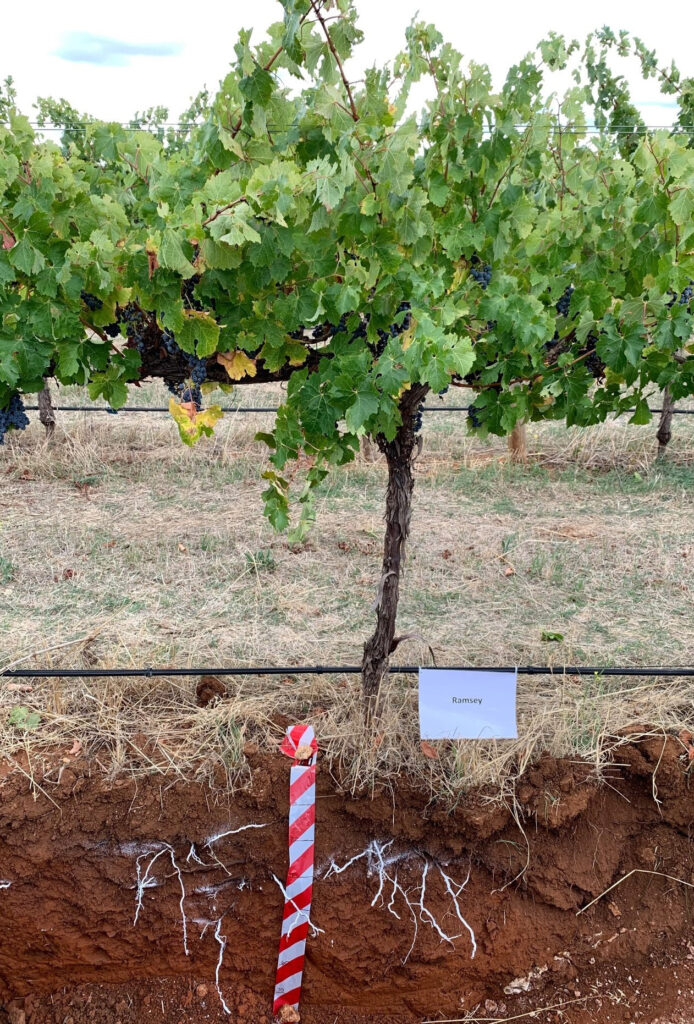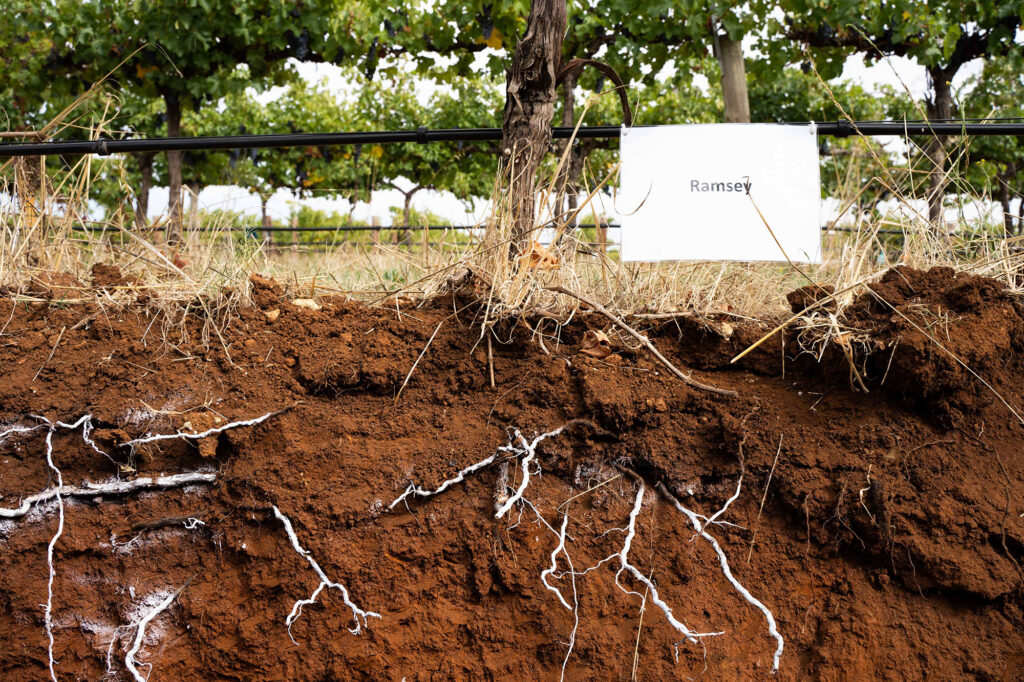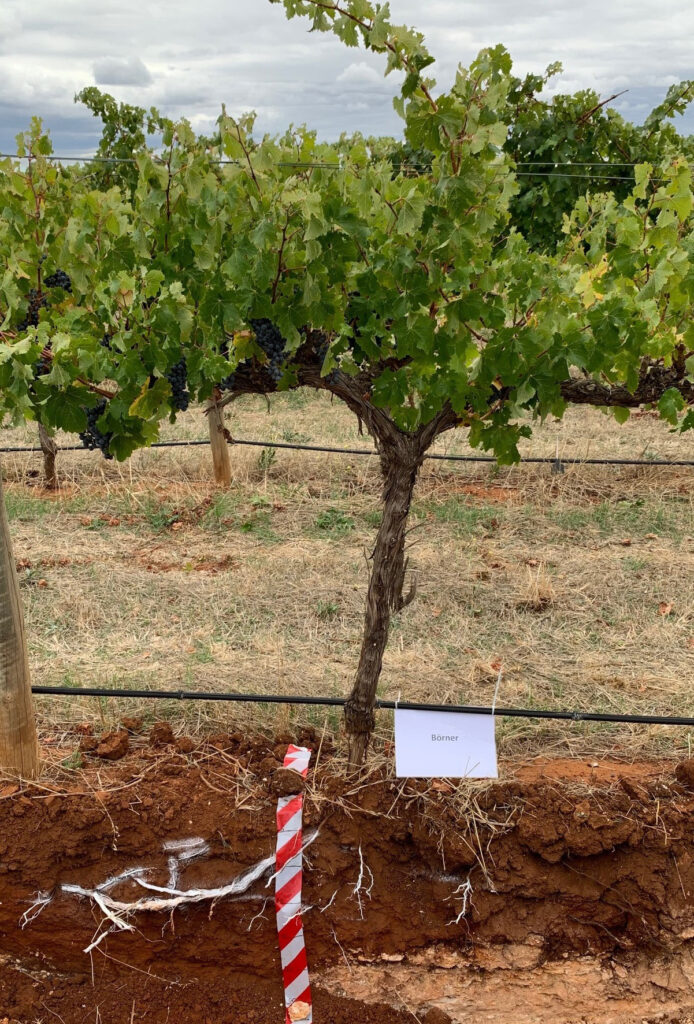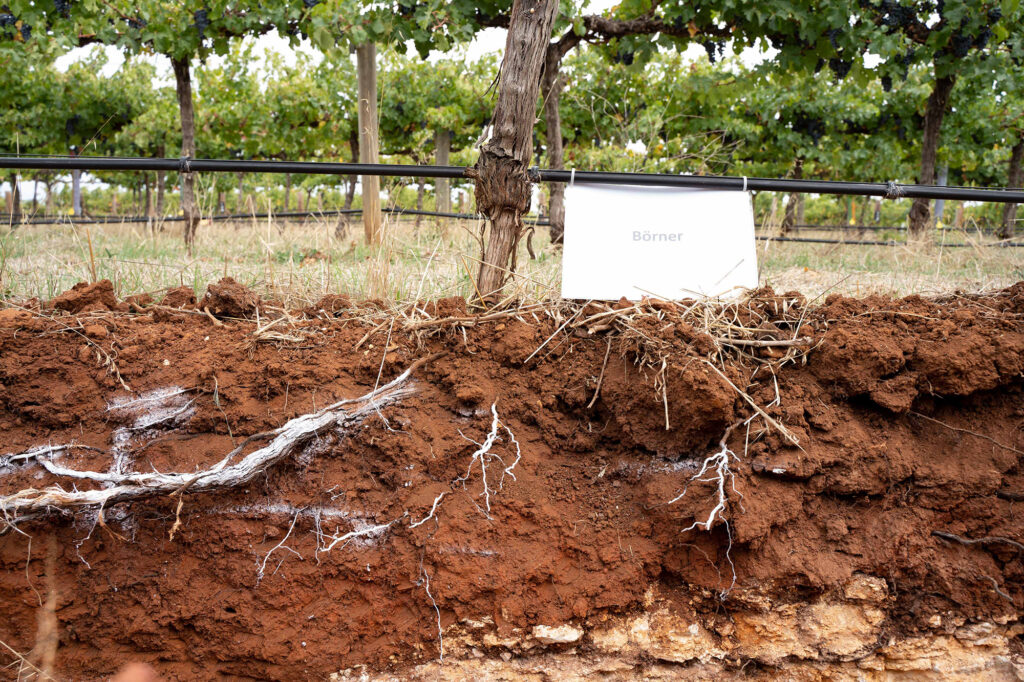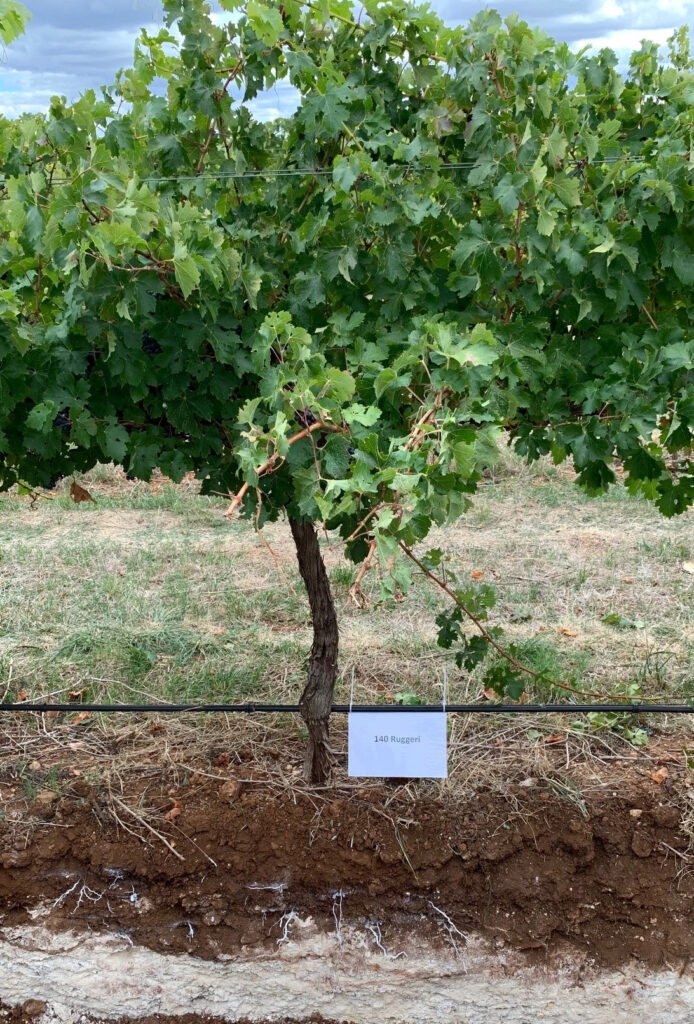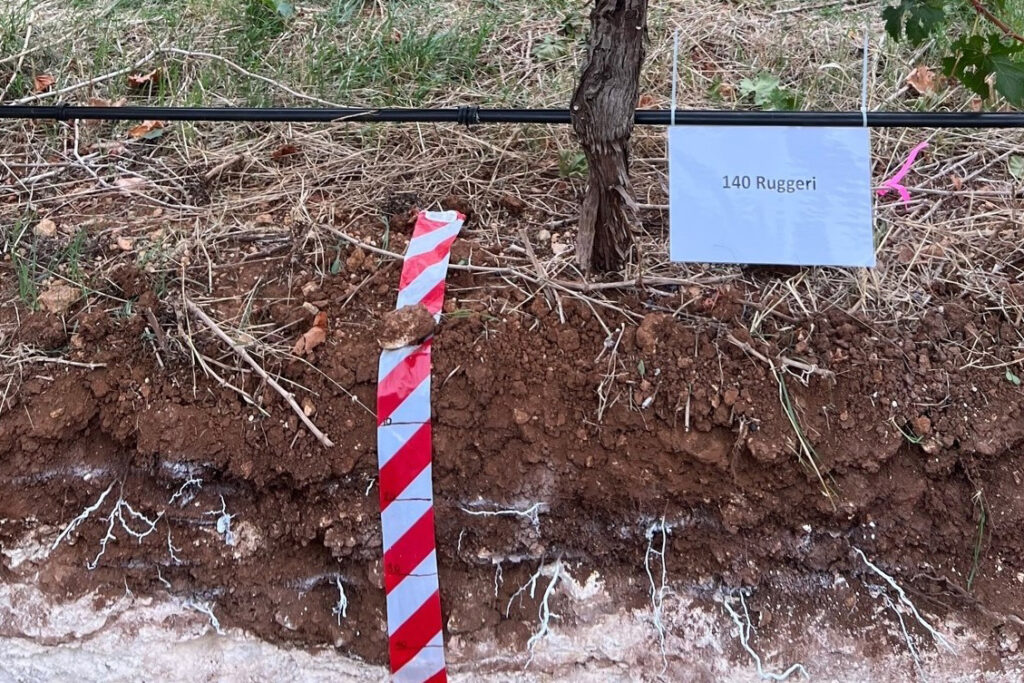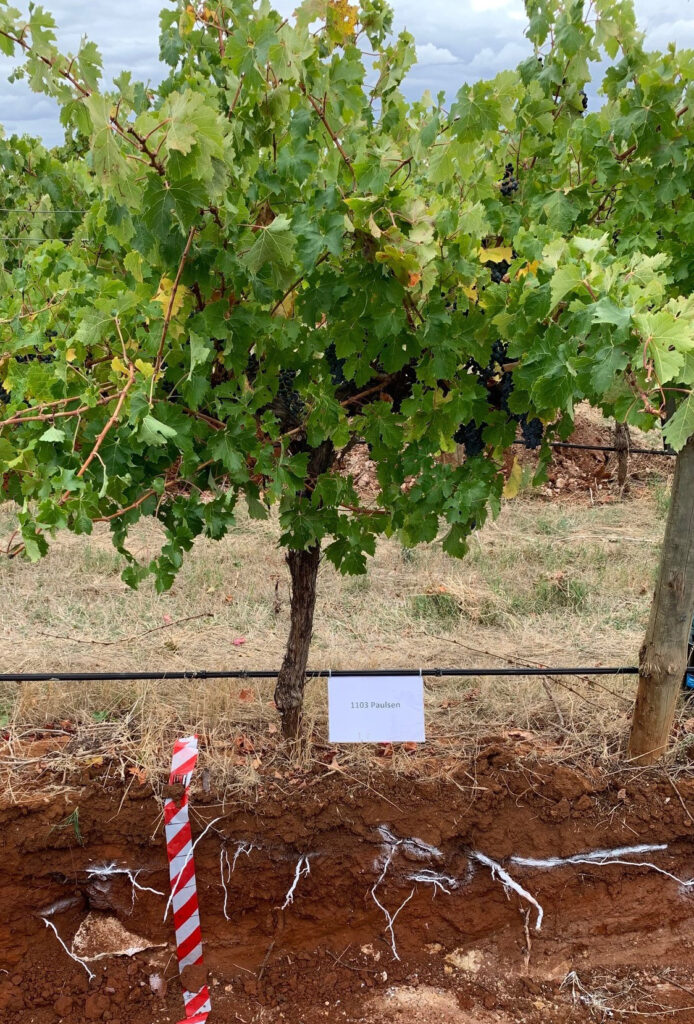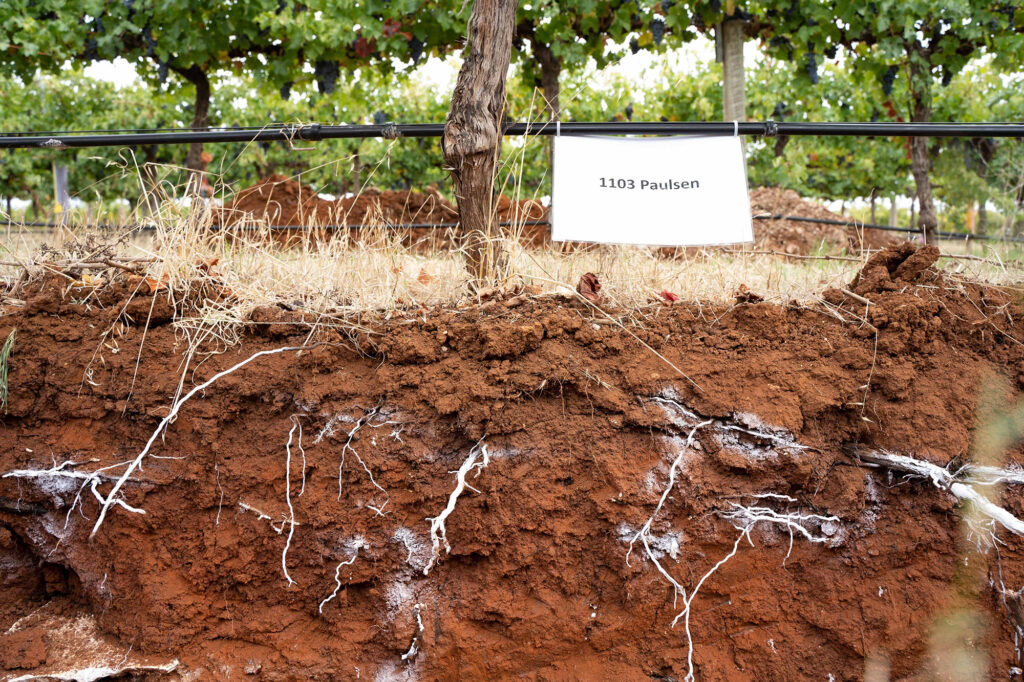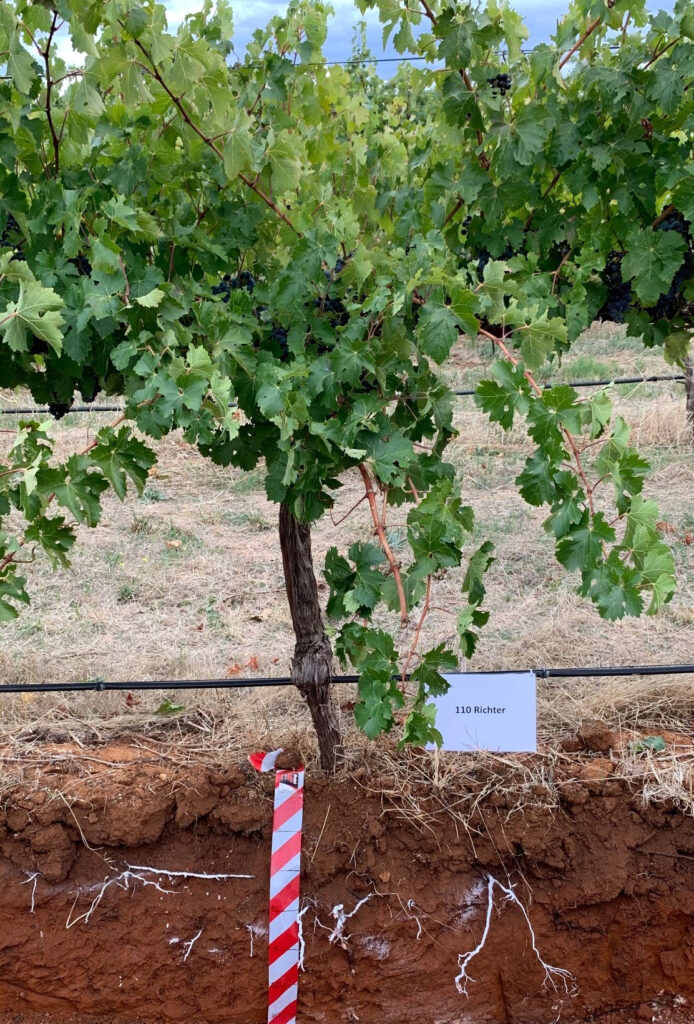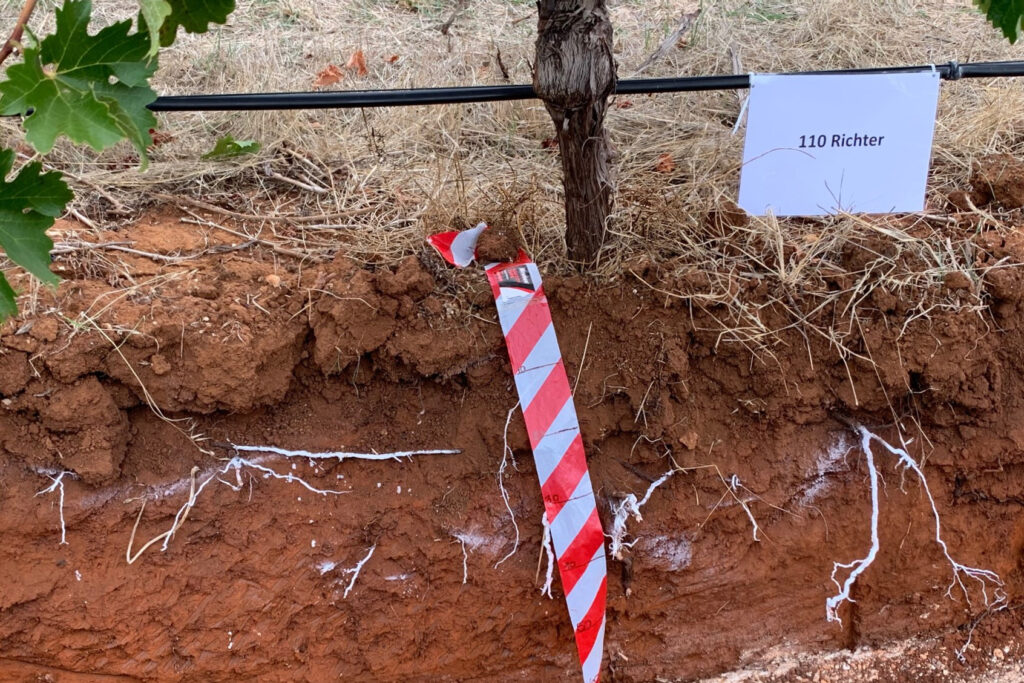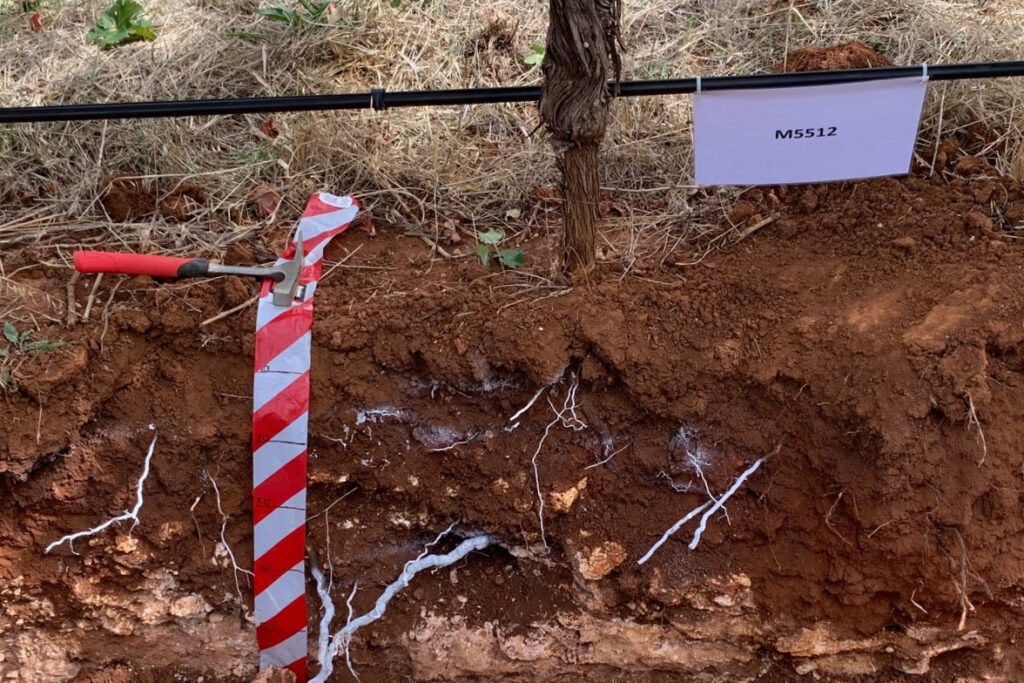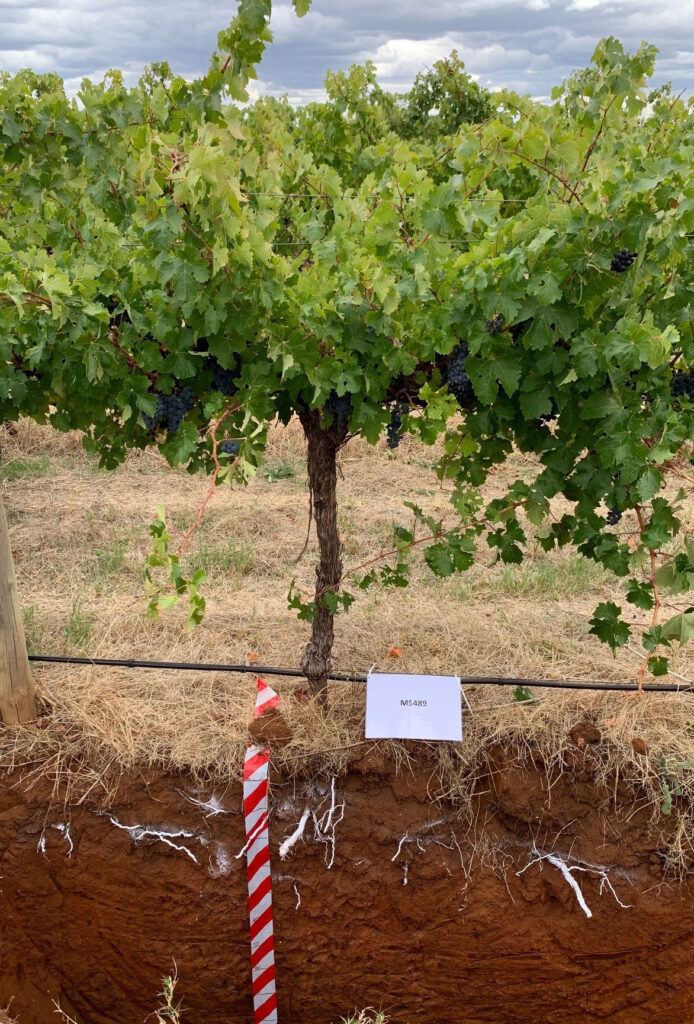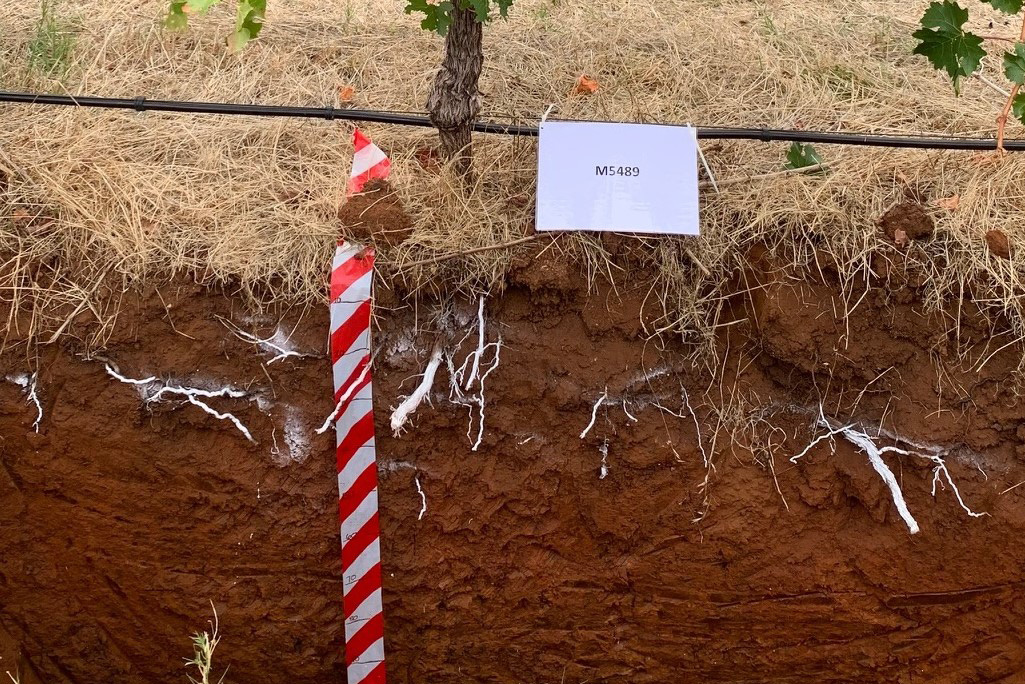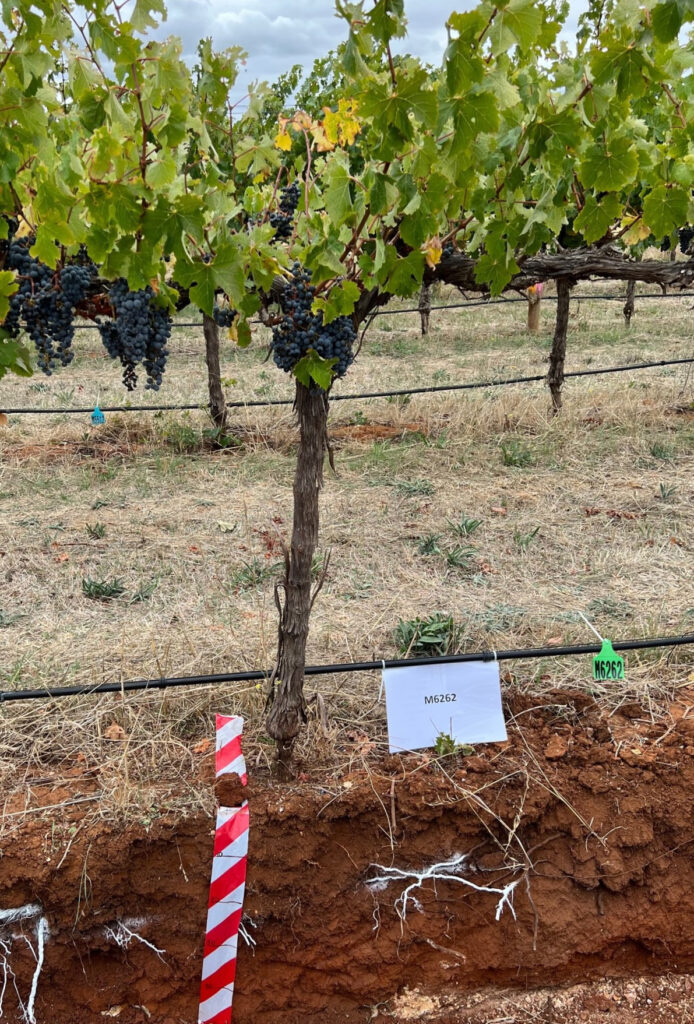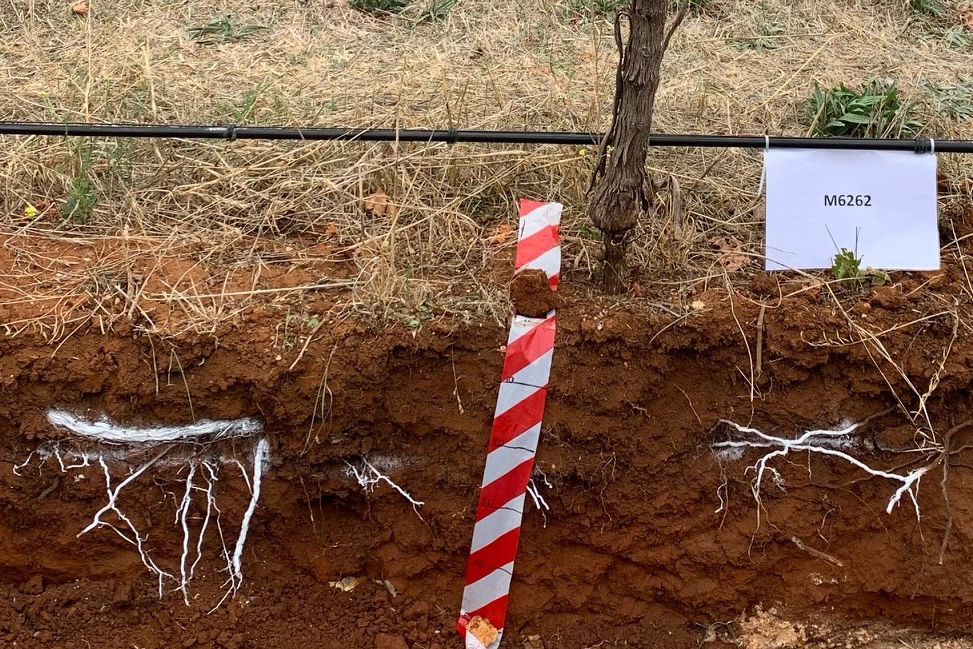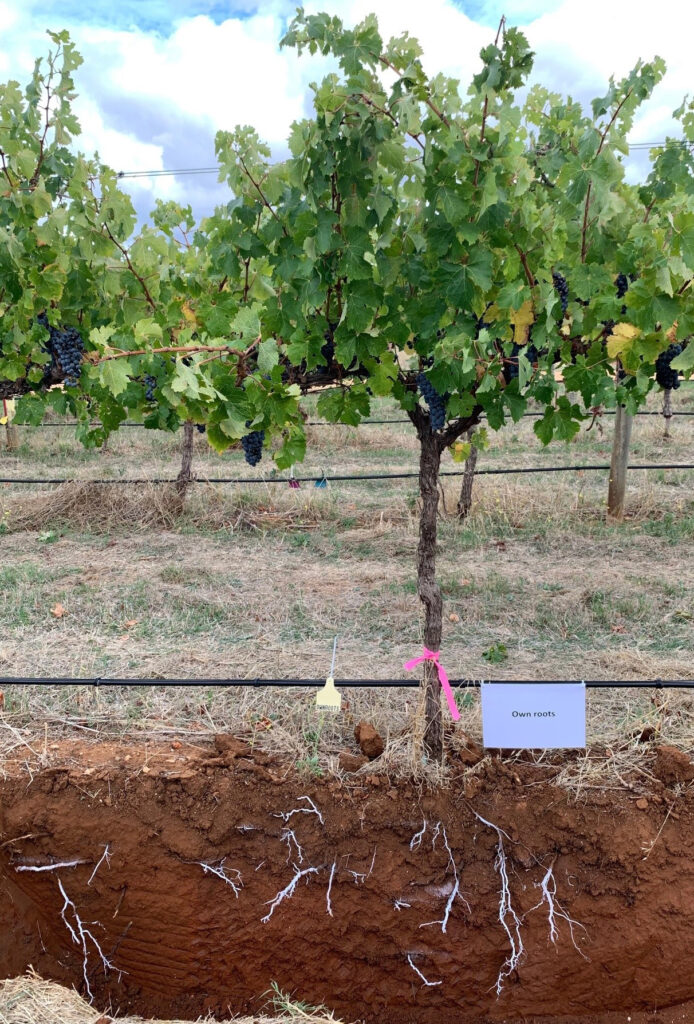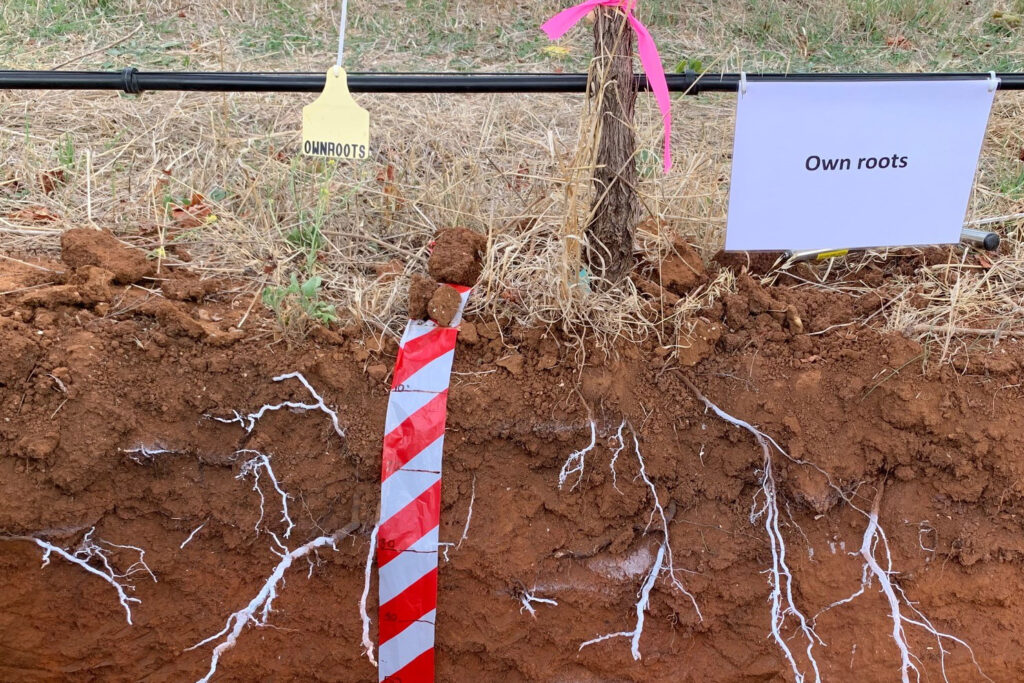Rootstock use in South Australia is currently limited to about one quarter of plantings. Own rooted vines are susceptible to phylloxera. Phylloxera tolerant roostocks can provide insurance against phylloxera destruction.
A long term, randomised and replicated rootstock trial was established in 2009 as a partnership between Vinehealth Australia, Wynns Coonawarra Estate and Coonawarra Vignerons, on the region’s famed terra rossa soil. The trial compares the performance of own-rooted Cabernet Sauvignon (CW 44 clone) vines against that of eight rootstocks of varying vigour.
Up until now, the trial has focused on homogenous management of the rootstocks. This has resulted in ‘managing to the median’ and therefore obvious differences in yield and vigour between the most and least inherently vigorous rootstocks.
The rootstocks in the trial are:
Root Measurements 2022
In April 2022, a Field Day was held at the trial site to view soil pits and discuss the importance of applying variable management strategies to rootstocks to achieve yield and quality outcomes, based on a rootstock’s inherent genetics and ability to access and use soil water.
The field day highlighted the importance of rootstock choice, where the rootstock is considered in the context of a number of factors including the scion variety, soil structure, desired yield and quality specifications, and current and future climate. Other factors such as vine spacing and soil preparation will all impact how the chosen planting material grows at the site.
The field day was supported by the Limestone Coast Landscape Board’s Grassroots Grants program and was funded by regional landscape and water levies.
Ramsey
Rootstock name: Ramsey (“traditionally high vigour, drought tolerant rootstock appearing to be curtailed in restricted soils”)
Parentage |
Vitis champinii |
-
A hybrid grape considered the result of natural hybridisation of Vitis mustagensis (V. candicans) x Vitis rupestris, originating from the Edwards Plateau in Texas.
-
Excellent drought tolerance and high water-use efficiency
-
Good salinity tolerance
-
High resistance to all but dagger nematodes
-
Can induce high potassium in red varieties
-
Moderate lime tolerance
-
Long vegetative cycle
|
Listed vigour rating |
|
Listed yield rating |
|
Relative performance in trial |
-
Third lowest average yield rank of all rootstocks over 5 seasons (V15, V16, V19, V21, V22), only above Börner, OR and M6262; close to median
-
Compared to V15 when highest-yielding of all rootstocks, Ramsey has been grouped with the lower yielding rootstocks in V19, V21 and V22 → perhaps indicative of its self-regulation and display of low-moderate vigour in the terra rossa soil type.
-
Low-moderate vigour
-
Homogenous management is tailored to the median, being similar to but a little more vigorous than Ramsey. It may therefore perform slightly better with additional irrigation.
|
2019 small lot wine quality rating |
-
Fourth most liked wine overall; part of the least liked Cluster of wines, including 140R, 1103P and 110R.
-
The aroma and palate of this wine was grouped with wines from 1103P, 110R and 140R, all described as “high for savoury, herbal, green, red fruit, acidic, floral, earthy and delicate” attributes, and in addition the wine was described as “fruity, spicy and fresh”
-
The appearance of this wine also grouped with Ramsey, 110R and 140R, being high in “red” and “clear”, and in addition the wine was described as “dense”
|
2022 observations |
-
Low-moderate vigour
-
Third lowest yielding rootstock behind OR and M6262
-
Yielded similarly to OR and Börner, with similar bunches per vine and bunch weight and similar vigour to these rootstocks
-
Second lowest rooting density behind Börner and M6262; low-moderate rooting volume equal with OR
|
Other |
|
Borner
Rootstock name: Börner “a true phylloxera resistant rootstock bred in Germany”
Parentage |
Vitis riparia x Vitis cinerea cv. Arnold |
-
A German-bred rootstock with true phylloxera resistance and excellent grafting and rooting ability
-
A hybrid from parents that both prefer cool, moist environments with uninterrupted water supply.
-
Not suited to extremely calcareous soils
-
Moderate – poor rooting ability
-
Can suffer from iron-chlorosis under wet conditions
|
Listed vigour rating |
|
Listed yield rating |
|
Relative performance in trial |
-
Second lowest average yield rank of all rootstocks over 5 seasons (V15, V16, V19, V21, V22), only above OR and M6262
-
Low vigour; considerable basal leaf yellowing at harvest
-
Homogenous management appears to be resulting in insufficient irrigation applied to this rootstock to maintain canopy health
|
2019 small lot wine quality rating |
-
Ranked 4th lowest yield (8.0/Ha) in 2019; canopy leaf area index was similar to OR and M6262, all being significantly lower than the other rootstocks and yield: pruning wt ratio classified it as moderate vigour
-
Berries and rachis at harvest had the lowest methoxypyrazine levels of all rootstocks except M6262, associated with very open canopies
-
This was rated as the most liked wine and had the lowest crush baume at 13.3
-
Highest wine colour density and lowest wine hue; highest wine anthocyanins, phenolics and wine pigmented tannin
-
The aroma and palate of this wine was grouped with wines from OR and M5512, all described as “high for dark fruit, riper, rounder, dense, fleshy, complex and concentrated” attributes
-
The appearance of this wine also grouped with OR and M5512, being high in “purple”
|
2022 observations |
-
Yielded similarly to Ramsey and OR, with similar bunches per vine and bunch weight
-
Similar low vigour as Ramsey and OR
-
Equal lowest rooting density with M6262; second lowest root volume, only above that of M6262
-
Soil pit showed showed fine, medium and large roots but not many of them; some very large laterally-growing roots
|
Other |
-
Need to establish and manage in light of parentage i.e. water availability and lime tolerance
-
Possibly needs deeper soils, closer planting, more irrigation, less calcareous soils
-
Limited commercial availability in Australia
-
Should be considered for further commercial evaluation
|
140 Ruggeri
Rootstock name: 140 Ruggeri (140R) “a high vigour, drought tolerant option”
Parentage |
Vitis berlandieri x Vitis rupestris |
-
A hybrid from parents originating from non-fertile, limestone hills in the hot, dry climate of Texas; and from parents native to the Eastern United States growing in deep, gravelly, rocky soils next to mountain streams
-
Excellent drought-tolerance and high water-use efficiency
-
High resistance to root knot nematode; low resistance to root-lesion and citrus nematode
-
Good salinity tolerance
-
High lime tolerance
-
Long vegetative cycle
|
Listed vigour rating |
|
Listed yield rating |
|
Relative performance in trial |
-
Highest average yield rank of all rootstocks over 5 seasons (V15, V16, V19, V21, V22)
-
Consistently highest vigour rootstock with large trunk diameter
-
Vigour could be managed with higher bud number, less irrigation, canopy management and accompanied by yield control, to contribute to improving potential wine quality
|
2019 small lot wine quality rating |
-
Ranked 4th highest yield (8.9T/Ha) and yield:pruning wt ratio classified it as high vigour.
-
Berries and rachis at harvest had highest methoxypyrazine levels of all rootstocks, associated with canopy shading
-
Equal least-liked wine with 1103P and part of the least liked Cluster of wines, including 1103P, 110R and Ramsey.
-
The aroma and palate of this wine was grouped with wines from Ramsey, 110R and 1103P, all described as “high for savoury, herbal, green, red fruit, acidic, floral, earthy and delicate” attributes, and in addition the wine was described as “fresh”
-
The appearance of this wine also grouped with Ramsey, 110R and 1103P, being high in “red” and “clear”, and in addition the wine was described as “dense”
|
2022 observations |
-
High vigour
-
Second highest yield rank behind M5489; with largest bunch weight of all rootstocks
-
Highest rooting density; second highest root volume equal to M5489 and behind 1103P, 110R and M5512.
-
Only soil pit showing root growth in midrow; contributing to maintenance of vigour and yield
|
Other |
-
Very hardy rootstock suitable for the most challenging drought conditions
-
Best suited to low and moderate depth soils where vigour can be controlled
-
Can be difficult to manage vigour in seasons with a wet spring and/or where frost control is required
|
1103 Paulsen
Rootstock name: 1103 Paulsen (1103P) “a high vigour, drought tolerant option”
Parentage |
Vitis berlandieri x Vitis rupestris |
-
A hybrid from parents originating from non-fertile, limestone hills in the hot, dry climate of Texas; and from parents native to the Eastern United States growing in deep, gravelly, rocky soils next to mountain streams
-
Excellent drought-tolerance and high water-use efficiency
-
Moderate – high resistance to root knot nematode; moderate resistance to root-lesion and citrus nematode; low resistance to dagger nematode
-
Excellent salinity tolerance
-
Moderate – high lime tolerance
-
Long vegetative cycle
|
Listed vigour rating |
|
Listed yield rating |
|
Relative performance in trial |
-
Fourth highest average yield rank of all rootstocks over 5 seasons (V15, V16, V19, V21, V22) behind 140R, M5512 and M5489; appearing to decline in yield rank in more recent seasons → a potential impact of homogenous management and lack of vigour control causing shading and the fruit zone and potentially lowering fruitfulness
-
Consistently high vigour
-
Vigour could be managed with higher bud number, less irrigation, canopy management and accompanied by yield control, to contribute to improving potential wine quality
|
2019 small lot wine quality rating |
-
Ranked 5th highest yield (8.1T/Ha) and yield:pruning wt ratio classified it as high vigour.
-
Equal highest crush baume at 13.8 with M5489 and 110R.
-
Highest juice potassium, along with OR.
-
Equal least-liked wine with 140R and part of the least liked Cluster of wines, including 140R, 110R and Ramsey.
-
The aroma and palate of this wine was grouped with wines from Ramsey, 110R and 140R, all described as “high for savoury, herbal, green, red fruit, acidic, floral, earthy and delicate” attributes
-
The appearance of this wine also grouped with Ramsey, 110R and 140R, being high in “red” and “clear”, and in addition the wine was described as “dense”
|
2022 observations |
-
High vigour
-
Fourth highest yield rank, behind M5489, 140R and M5512; with similar bunches per vine to 140R and M5512, but slightly lower bunch weight.
-
Second highest rooting density, equal to M5512 and behind 140R; and equal highest root volume with 110R and M5512
|
Other |
|
110 Richter
Rootstock name: 110 Richter (110R) “a moderate vigour, drought tolerant option”
Parentage |
Vitis berlandieri x Vitis rupestris |
-
A hybrid from parents originating from non-fertile, limestone hills in the hot, dry climate of Texas; and from parents native to the Eastern United States growing in deep, gravelly, rocky soils next to mountain streams
-
Excellent drought-tolerance and high water-use efficiency
-
Moderate resistance to root knot nematode and citrus nematode; low resistance to root-lesion and dagger nematode
-
Tolerates salinity better than own roots
-
Moderate – high lime tolerance
-
Long vegetative cycle
|
Listed vigour rating |
|
Listed yield rating |
|
Relative performance in trial |
-
Median yield rank of all rootstocks over 5 seasons (V15, V16, V19, V21, V22)
-
Moderate vigour; current homogenous management is biased towards this rootstock. Potential for better performance in wine quality in future.
-
Canopy management and yield control in cooler seasons especially might enhance quality potential
|
2019 small lot wine quality rating |
-
Ranked 3rd highest yield (9.5T/Ha) and with a canopy less vigorous that 1103P and 140R, but still moderate-high vigour. Had highest berry weight.
-
Equal highest crush baume at 13.8 with M5489 and 1103P.
-
Third least liked wine overall, and part of the least liked Cluster of wines, including 140R, 1103P and Ramsey.
-
The aroma and palate of this wine was grouped with wines from 1103P, 110R and 140R, all described as “high for savoury, herbal, green, red fruit, acidic, floral, earthy and delicate” attributes, and in addition the wine was rated high for “reductive and intense” characters → potentially indicative of a winemaking fault
-
The appearance of this wine also grouped with Ramsey, 110R and 140R, being high in “red” and “clear”
|
2022 observations |
-
Moderate vigour / balanced canopy
-
Median yield rank, with slightly lower number of bunches per vine compared to higher-yielding rootstocks
-
Average rooting density behind 140R, 1103P and M5512; and equal highest root volume with 1103P and M5512
-
Soil pit showed lots of moderate-sized roots
|
Other |
|
Merbein 5512
Rootstock name: Merbein M5512 (M5512) “Australian bred low potassium rootstock with high water use efficiency”
Parentage |
Complex hybrid from Vitis berlandieri |
-
CSIRO Merbein-bred rootstock for low berry potassium uptake
-
A hybrid from parents that grew in the hot, dry climate of south-west Texas and parents that preferred cool, moist environments with uninterrupted water supply
-
Enhances wine colour and phenolics
-
Enhances wine colour and phenolics
-
High water-use efficiency
-
Good nematode tolerance
-
Ability to exclude salt is similar to 1103P
|
Listed vigour rating |
|
Listed yield rating |
|
Relative performance in trial |
-
Second highest average yield rank of all rootstocks over 5 seasons (V15, V16, V19, V21, V22) behind 140R
-
Moderate – high vigour / good vine balance
|
2019 small lot wine quality rating |
-
Ranked highest in yield (13.2T/Ha) in 2019; had highest bunch weight driven by berries per bunch; yield:pruning wt ratio most similar to Börner and M6262 indicative of moderate rather than high vigour
-
Consistently low in grape juice and wine ions
-
Lowest in grape juice potassium with M5489.
-
With M5489 was part of the second most liked cluster of wines.
-
The aroma and palate of this wine was grouped with wines from OR and Börner, all described as “high for dark fruit, riper, rounder, dense, fleshy, complex and concentrated” attributes
-
The appearance of this wine also grouped with OR and Börner, being high in “purple” and in addition the wine was described as “dense”
|
2022 observations |
-
Moderate-high vigour, 3rd highest yield (similar bunch number per vine and bunch weight to 1103P and 140R)
-
Second highest rooting density behind 140R and equal highest root volume with 1103P and 110R
-
Soil pit showed some very thick tap roots and right-angled roots impacted by wheel traffic compaction
|
Other |
|
Merbein 5489
Rootstock name: Merbein 5489 (M5489) “Australian bred low potassium rootstock with high water use efficiency”
Parentage |
Complex hybrid from Vitis berlandieri |
-
CSIRO Merbein-bred rootstock for low berry potassium uptake
-
A hybrid from parents that grew in the hot, dry climate of south-west Texas and parents that preferred cool, moist environments with uninterrupted water supply
-
Enhances wine colour and phenolics
-
High water-use efficiency
-
Good nematode tolerance
-
Ability to exclude salt is similar to 1103P
|
Listed vigour rating |
|
Listed yield rating |
|
Relative performance in trial |
-
Third highest average yield rank of all rootstocks over 5 seasons (V15, V16, V19, V21, V22) behind 140R and M5512; but highest yielding rootstock in V21 and V22
-
Moderate – high vigour / good vine balance
|
2019 small lot wine quality rating |
-
Ranked 2nd highest yield (9.6T/Ha) and moderately high in vigour
-
Equal highest crush baume at 13.8 with 1103P and 110R.
-
Lowest in grape juice potassium with M5512.
-
With M5512 was part of the second most liked cluster of wines.
-
The wine was described as high in “floral and earthy” tones and these attributes were not shared by other wines
|
2022 observations |
-
Highest yielding rootstock by a long way, with considerably higher bunch number per vine than 140R and 1103P; second highest bunch weight behind 140R
-
Moderate-high vigour canopy perhaps contributing to higher fruitfulness than 140R and 1103P
-
Third lowest rooting density, equal to OR and second highest root volume with 140R
|
Other |
|
Merbein 6262
Rootstock name: Merbein 6262 (M6262) “Australian bred low potassium rootstock but poor salt excluder”
Parentage |
Complex hybrid from Vitis cinerea |
-
CSIRO Merbein-bred rootstock for low berry potassium uptake
-
A hybrid from parents that grew in the hot, dry climate of south-west Texas and parents that preferred cool, moist environments with uninterrupted water supply
-
Enhances wine colour and phenolics
-
Good nematode tolerance
-
Poor salt excluder
-
Lower tolerance to phylloxera compared to M5489 or M5512
|
Listed vigour rating |
|
Listed yield rating |
|
Relative performance in trial |
-
Consistently the lowest vigour with considerable leaf yellowing and tired canopy at harvest
-
Equal lowest average yield rank of all rootstocks over 5 seasons (V15, V16, V19, V21, V22) with OR
-
Comparatively thin vine trunk, significantly thinner than all other rootstocks except for own roots
-
Homogenous management appears to be resulting in insufficient irrigation applied to this rootstock to maintain canopy health
|
2019 small lot wine quality rating |
|
2022 observations |
-
Shortest shoots, considerable leaf yellowing
-
Lowest yield (same bunch number per vine as OR but lowest bunch weight of all rootstocks)
-
Equal lowest rooting density with Börner and lowest root volume
|
Other |
|
Own roots
Rootstock name: Own roots (OR) “our control”
Parentage |
Vitis vinifera |
|
Relative performance in trial |
-
Consistently low vigour
-
Comparatively thin vine trunk, significantly thinner than all other rootstocks except M6262
-
Equal lowest average yield rank with M6262 of all rootstocks over 5 seasons (V15, V16, V19, V21, V22)
-
Homogenous management appears to be resulting in insufficient irrigation applied to this rootstock to maintain canopy health
|
2019 small lot wine quality rating |
-
Was lowest yielding of all rootstocks at 5T/Ha in 2019; had lowest bunch weight, driven by lowest berries per bunch; canopy leaf area index was similar to Börner and M6262, all being significantly lower than the other rootstocks
-
Lowest titratable acidity and highest pH at crush.
-
Highest juice potassium along with 1103P.
-
OR wine was used as the ‘pivot’ wine and therefore a preference score was not provided for this wine in comparison to the other wines.
-
The aroma and palate of this wine was grouped with wines from M5512 and Börner, all described as “high for dark fruit, riper, rounder, dense, fleshy, complex and concentrated” attributes.
-
The appearance of this wine also grouped with M5512 and Börner being high in “purple”.
|
2022 observations |
-
Low vigour, basal leaf yellowing
-
Second lowest yield rank, only above M6262; with similar yield, bunches per vine and bunch weight to Ramsey
-
Low to moderate rooting density and root volume
|
Other |
|
Small Lot Winemaking 2019
Small lot winemaking was undertaken for the first (and only time to date) time on the Coonawarra Rootstock Trial in 2019. Around 50kg of all but M6262 rootstock was hand harvested in duplicate and then made into small lot wines by the AWRI Commercial Services.
As a means of comparing these wines, a selected group of trained regional winemakers was guided through a rapid sensory method called “Pivot Profile” by the AWRI, whereby the own rooted wine was used as the pivot wine.
Wines showed varied sensory profiles, with three groups (clusters) of wines identified from the analysis.
Cluster 1 consisted of the Ramsey, 110R, 140R and 1103P rootstocks and was rated high for Red colour, Red Fruit aroma and flavour, Acid, Green aroma and flavour and Herbal aroma among others.
Cluster 2 contained M5512 and M5489 and the Own Roots wine, and was high in Intense and Dense appearance, Fresh, Complex and Long palate, and Earthy and Floral aroma.
Cluster 3 consisted of only the Börner sample and was high in Purple colour, Dark Fruit aroma/palate, ripe aroma/palate, and Round and Dense palate. Preference scores revealed Cluster 3 to be the most liked and Cluster 1 the least liked.
DOWNLOAD
2022 Report_ HCG CRT Soil Root Assessment
2022 Presentation N Dry CRT Rootstock selection
2022 Presentation HCG_CRT Vineyard Soil Management
2022 Presentation VHA_CRT Field Day
2020 Report CRT Looking back and looking forward
2019 Rootstock Trial winemaking results

